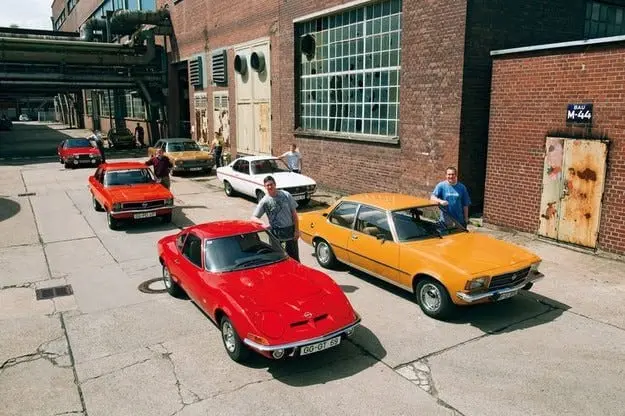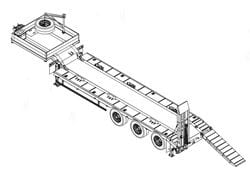
Test drive when Opel was number 1: Seven models of the 70s

Seven cars that have become part of the life of generations of Germans
The XNUMXth was the decade of Opel – colorful, trendy, exciting and versatile. The brand, rich in tradition, was in very good shape with seven model ranges ranging from compact to luxury cars, from station wagons for family travel to sporty two-seat coupes.
Inside the Opel showrooms, there was a real intoxication of paints and all kinds of equipment - blue Mozart, cardinal red, yellow Sahara and versions like SR, GT / E or Berlinetta. Twice, in 1972 and 1973, Opel overtook Volkswagen with over 20 percent market share in Germany. Seven iconic Opel models bring this glorious decade to life.
Opel and life in the seventies
Opel is a kind of worldview. For many of us, this can be described by such concepts as carelessness, warmth, longing. In the XNUMXs, sooner or later, everyone met Opel. Ascona or Record are imprinted in memory with their aroma, engine noise, their shape and color, and they stayed there forever, whether you like it or not. Surely someone around owned an Opel - you, family, friends, a girl. Opel looked desperately like a guild or a rebel. Opel, it was lamb skins and a fox tail, born of tuning-lover monsters or "grandfather's wagon." If we have remembered enough images in your memory, it's time to turn the key in the socket and make a circle together.
None of them had more than one camshaft, that will come later; a rigid rear axle also lasts a long time. Five-speed gearboxes were a utopia, and four-disc brakes were only available at 165 hp. up. The previous show was the work of the devil. Timing belts are a dangerous poison. Horizontal flow aluminum cylinder heads were considered exclusive to racing bikes. Even tuning on the Opel was usually made from finished parts. If you want more power, you simply install the engine with the next highest power and that's it.
In its XNUMXs models, Opel exudes conservatism and perseverance, without experimentation or daring technical solutions. Called Kadett, Ascona or Commodore, the Rüsselsheim cars had a simple yet surprisingly efficient design, without pitfalls and treacherous surprises. This honesty towards the client makes them so loved to this day. No novice driver runs into problems with the Kadett C, no amateur driver risks damaging the spark plug thread in an Ascona engine.
Many of us had an Opel
We admit that only the Opel GT has possessed the charm of Alfa Bertone or Renault Alpine. But even this Coke-bottle-hulled athlete hides a combination of Kadett B and Rekord C under his sheets. In the event of an accident, any roadside assistance vehicle will be able to repair it without problems. Opel has taken prefabricated components to the extreme in the name of low cost and reliability.
After all, my Rekord D took me anywhere, anytime, even eight years later, when its sills were already welded on and the fenders were sealed with fiberglass. Only once, almost late - at night along the A3 highway. It was the water pump, a typical Opel disease. Twenty kilometers from the nearest gas station, the thermometer needle was red, but the cylinder head gasket held because it was an Opel.
Perhaps we think the seven seventies Opel models are so good precisely because they give more than they get. In order not to leave us in trouble, they go to self-sacrifice. At the same time, they are outwardly quite pleasant. Opel designers, under the leadership of Charles Jordan, created seven masterpieces in those years that were far from American style and focused on light lines in the Italian spirit. This new Opel signature achieves amazing shape perfection in the Manta A, Rekord D and of course the gorgeous GT.
Teacher with Opel GT - dream woman and dream car
How can I forget the GT, that cool high school teacher used to drive it, didn't he? The dream woman and the dream car are both unattainable. One day she put me in the car when I missed the bus… Today I decide to try the GT, but before that I have to sit down. Finally, I sit down as if soldered - to feel how well the car goes in fast corners, how accurately the gears change. A real pleasure - because the pleasure of precise shifting is part of the Opel experience. Engine Record 90 hp it's not a rocket, but it easily carries 980 pounds of GT. Its power depends on the displacement, not on the number of revolutions - this is also an element of the Opel creed - a calm and carefree driving with the ability to accelerate from 60 km / h in fourth gear.
I myself had a Record D, as a car for every day in the eighties. It had two ocher colored doors - as shown here, the power of the machine is 1900 cc. limited to 75 hp power. But the model we're driving today has a gear lever on the steering wheel. At the time, we thought that with it, the Rekord D, perceived as a dynamic model, would become a phlegmatic car for pensioners; Today, however, I wholeheartedly enjoy every shift, and Rekord delivers an even quieter, smoother ride. When you sit deep in easy chairs, what is happening outside becomes somehow indifferent to you.
Opel Athletes – Commodore GS/E & Blanket A
Compared to the Rekord, the Commodore coupe is a sharper weapon. Three Weber carburetors deliver powerful pulling power supported by the sound of a sporty twin-pipe exhaust. Our dentist was driving a GS/E – I remember standing in front of his house, painted a low-key green, with no “battle scenery.” I've always wanted one, but after that Rekord D, I could only afford a 115hp Commodore Spezial. and a solid consumption of 15 liters per 100 km, but with immunization against breakdowns. Without thinking, I changed the oil every 30 km, and valve adjustment was no longer required thanks to hydraulic lifters. And this is Opel.
One bastard in my class at tech had a Manta A 1900 SR brand new—no wonder dad pays. This guy couldn't think of anything better than a hideous plastic curtain he nailed to the rear window and monstrous wide tires with Centra wheels. Now Manta Swinger with its innocent whiteness seems to heal old wounds. Refined lines, frameless side windows and exquisite details such as the stylized Manta ramp continue to delight the eye.
Feel like an Opel - the best in a big diplomat
If not for the Swinger, the model would have been a typical second car for wealthy ladies. The automatic softens its character by using the decent torque of the 1900cc engine. See. When you ride it, you immediately notice the agility thanks to the wonderfully direct steering. The Manta tends to corner with almost the same zeal as an optimally balanced GT. The car barely leans, and the suspension is stiffer than the Rekord D. In the chassis, the Opel models differ only in a few nuances - everywhere there are pairs of transverse beams in front and a well-mounted four-beam rigid axle in the back.
Only the Diplomat needs a velvet-like De Dion rear axle running gear. In our town, such a royal Opel was driven by a tie manufacturer who did not want to hear about Mercedes. Now I sit quietly in a wide plush chair, listen to the sonorous musical background of the six-cylinder engine, enjoy the smoothly switching automatic. I can feel the heavy car sliding gently down the road and I can feel the Opel.
BRIEF TECHNICAL DATA
Opel Diplomat B 2.8 S, 1976
Six-cylinder in-line gray cast iron engine with camshaft in the cylinder head, crankshaft with seven main bearings, displacement 2784 cm³, power 140 hp. at 5200 rpm, max. torque 223 Nm at 3600 rpm, two Zenith carburetors with adjustable damper, rear-wheel drive, three-speed automatic transmission, max. speed 182 km / h, 0 - 100 km / h in 12 seconds, consumption 15 l / 100 km.
Opel GT 1900, 1972
Four-cylinder in-line engine made of gray cast iron with a camshaft in the cylinder head, a crankshaft with five main bearings, a displacement of 1897 cc, 90 hp. at 5100 rpm, max. torque 144 Nm @ 2800 rpm, one Solex carburetor with adjustable damper, rear-wheel drive, four-speed manual transmission, max. speed 185 km / h, 0-100 km / h in 10,8 seconds, consumption 10,8 l / 100 km.
Opel Cadet C, 1200, 1974
1196-cylinder in-line engine made of gray cast iron with a bottom camshaft and valves in the cylinder head, crankshaft with three main bearings, displacement 52 cc, power 5600 hp at 80 rpm, max. torque 3400 Nm @ 139 rpm, one Solex vertical flow carburetor, rear wheel drive, four-speed manual transmission, max. speed 0 km / h, 100-19,5 km / h in 8,5 seconds, consumption 100 l / XNUMX km.
Opel Commodore B GS S, 1972
Six-cylinder in-line engine with a camshaft in the cylinder head, a crankshaft with seven main bearings, a displacement of 2490 cm³, an output of 130 hp. at 5100 rpm, max. torque 187 Nm @ 4250 rpm, two Zenith carburettors with adjustable damper, rear-wheel drive, four-speed manual transmission, max. speed 180 km / h, 0-100 km / h in 10,0 seconds, consumption 13,8 l / 100 km.
Opel Rekord D 1900 L, 1975
Four-cylinder in-line engine made of gray cast iron with a camshaft in the cylinder head, a crankshaft with five main bearings, a displacement of 1897 cm 75, an output of 4800 hp. at 135 rpm, max. torque 2800 Nm @ 152 rpm, one Solex vertical flow carburetor, rear wheel drive, four-speed manual transmission, max. speed 0 km / h, 100-16,8 km / h in 12 seconds, consumption 100 l / XNUMX km.
Opel Manta 1900 L, 1975
Four-cylinder in-line engine made of gray cast iron with a camshaft in the cylinder head, a crankshaft with five main bearings, a displacement of 1897 cc, 90 hp. at 5100 rpm, max. torque 144 Nm @ 3600 rpm, one Solex carburetor with adjustable damper, rear-wheel drive, three-speed automatic, max. speed 168 km / h, 0-100 km / h in 13,0 seconds, consumption 12,2 l / 100 km.
Opel Ascona A 1.6 S, 1975
Gray cast iron in-line four-cylinder engine, crankshaft with five main bearings, displacement 1584 cm³, power 75 hp. at 5000 rpm, max. torque 114 Nm at 3800 rpm, single Solex carburetor with adjustable damper, rear-wheel drive, three-speed automatic transmission, max. speed 153 km / h, 0 - 100 km / h in 15 seconds, consumption 11 l / 100 km.
Text: Alf Kremers
Photo: Arturo Rivas

